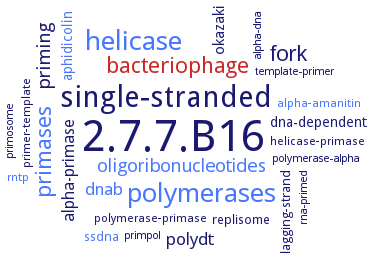2.7.7.B16: DNA primase
This is an abbreviated version!
For detailed information about DNA primase, go to the full flat file.

Word Map on EC 2.7.7.B16 
-
2.7.7.B16
-
single-stranded
-
helicase
-
polymerases
-
bacteriophage
-
primases
-
fork
-
priming
-
oligoribonucleotides
-
dnab
-
polydt
-
alpha-primase
-
okazaki
-
dna-dependent
-
aphidicolin
-
ssdna
-
lagging-strand
-
replisome
-
alpha-amanitin
-
primer-template
-
rntp
-
helicase-primase
-
polymerase-primase
-
rna-primed
-
polymerase-alpha
-
alpha-dna
-
primosome
-
primpol
-
template-primer
- 2.7.7.B16
-
single-stranded
- helicase
- polymerases
- bacteriophage
- primases
- fork
-
priming
- oligoribonucleotides
- dnab
-
polydt
-
alpha-primase
-
okazaki
-
dna-dependent
- aphidicolin
- ssdna
-
lagging-strand
-
replisome
- alpha-amanitin
-
primer-template
- rntp
-
helicase-primase
-
polymerase-primase
-
rna-primed
-
polymerase-alpha
-
alpha-dna
-
primosome
- primpol
-
template-primer
Reaction
Synonyms
archaeal eukaryotic-type primase, DNA primase-polymerase, DnaG primase, Mjpri, Pabp41, Pabp46, pIT3 replication protein, PolpTN2, PriL, PriS, PriSL, PriX, Sso core primase, SsoPriSL
ECTree
Advanced search results
Engineering
Engineering on EC 2.7.7.B16 - DNA primase
Please wait a moment until all data is loaded. This message will disappear when all data is loaded.
Y155A/Y156A/I157A
mutation reduces PriS binding 1000fold
D101A/D103A
the catalyric site mutant enzyme does not exhibit any detectable catalytic activity, even when higher concentrations of enzyme are utilised. The result demonstrate that the terminal transferase-like activity of PriSL is dependent on the catalytic activity of the primase. D101 and D103 are necessary for PriSL catalytic activity
F164E(PriS)
mutantion in small subunitPriS shows considerably weakened subunit association
F164G/I199K(PriS)_F142E/L163E(PriL)
double mutations of F164G/I199K in small subunit PriS and F142E/L163E in large subunit PriL abolishes the PriS-PriL interaction
G165I(PriS)
mutantion in small subunitPriS shows partial destabilization of the complex
N175A/R176
the affinity of DNA-binding site mutant for NTPs is approximately tenfold lower than that of the wild-type primase and that its enzymatic capability is diminished. Therefore, the mutation of N175 and R176 does not alter the DNA binding properties of the primase but modifies its affinity for free NTPs
R84A/R85A(PriL)
mutation in large subunit shows a marked reduction in the size and amount of RNA product synthesized
D101A/D103A
-
the catalyric site mutant enzyme does not exhibit any detectable catalytic activity, even when higher concentrations of enzyme are utilised. The result demonstrate that the terminal transferase-like activity of PriSL is dependent on the catalytic activity of the primase. D101 and D103 are necessary for PriSL catalytic activity
-
F164E(PriS)
-
mutantion in small subunitPriS shows considerably weakened subunit association
-
F164G/I199K(PriS)_F142E/L163E(PriL)
-
double mutations of F164G/I199K in small subunit PriS and F142E/L163E in large subunit PriL abolishes the PriS-PriL interaction
-
G165I(PriS)
-
mutantion in small subunitPriS shows partial destabilization of the complex
-
N175A/R176
-
the affinity of DNA-binding site mutant for NTPs is approximately tenfold lower than that of the wild-type primase and that its enzymatic capability is diminished. Therefore, the mutation of N175 and R176 does not alter the DNA binding properties of the primase but modifies its affinity for free NTPs
-
R84A/R85A(PriL)
-
mutation in large subunit shows a marked reduction in the size and amount of RNA product synthesized
-
additional information
mutant primase lacking the zinc-binding motifs has higher activity compared with the wild-type enzyme, as well as a bias toward shorter products of 30100 nucleotides
additional information
generation of a PriX deletion mutant that contains amino acid residues 26-154 for crystallization purposes
additional information
-
generation of a PriX deletion mutant that contains amino acid residues 26-154 for crystallization purposes
additional information
-
mutant primase lacking the zinc-binding motifs has higher activity compared with the wild-type enzyme, as well as a bias toward shorter products of 30100 nucleotides
-


 results (
results ( results (
results ( top
top






